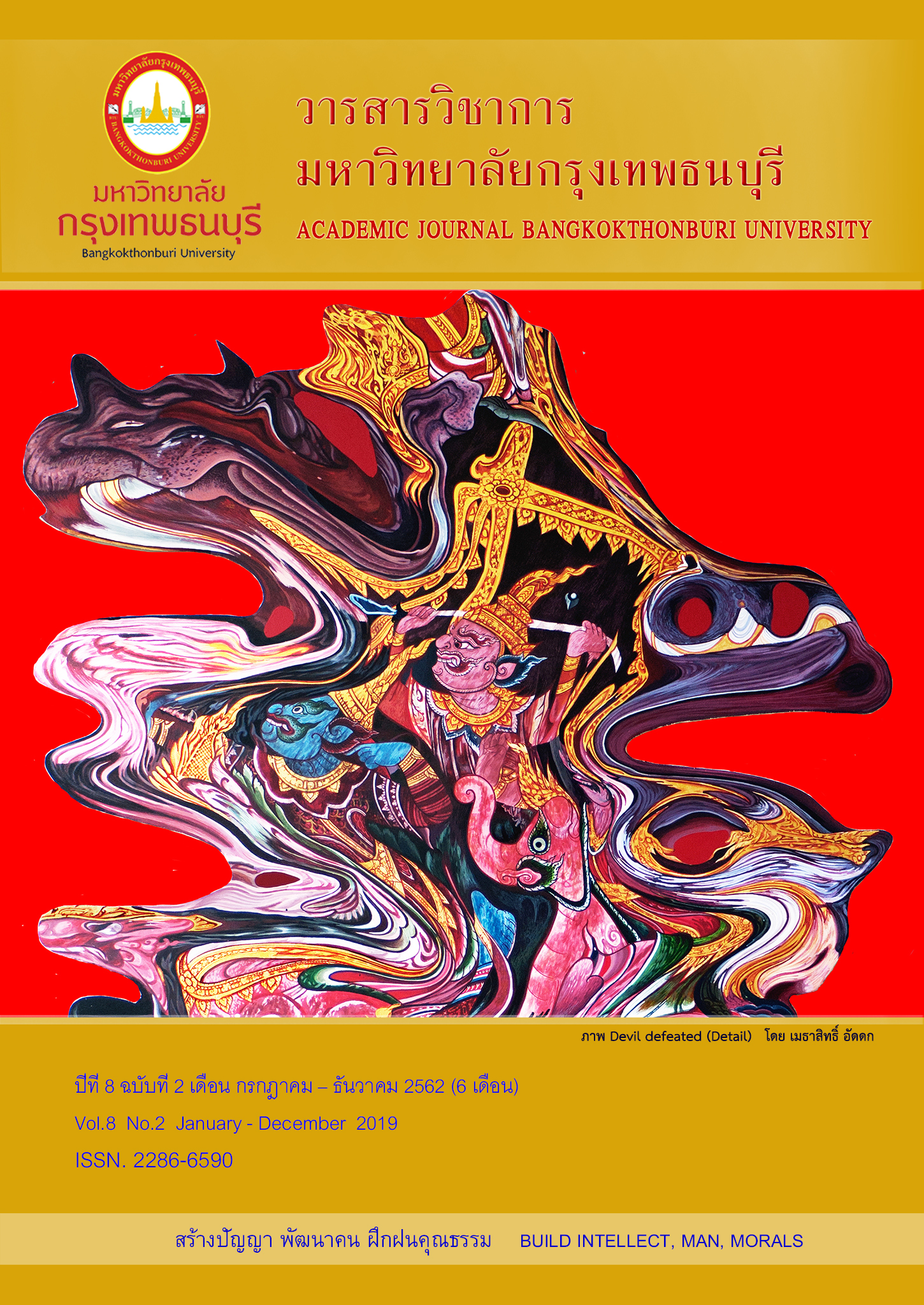การพัฒนาไมโครเลิร์นนิง สำหรับนักศึกษาระดับประกาศนียบัตรวิชาชีพชั้นสูง วิทยาลัยอาชีวศึกษาเอกชน ในเขตกรุงเทพมหานคร
Main Article Content
บทคัดย่อ
การวิจัยเชิงทดลองครั้งนี้ มีวัตถุประสงค์เพื่อ 1) พัฒนาไมโครเลิร์นนิง สำหรับนักศึกษาระดับประกาศนียบัตรวิชาชีพชั้นสูง วิทยาลัยอาชีวศึกษาเอกชน ในเขตกรุงเทพมหานคร ให้มีประสิทธิภาพตามเกณฑ์มาตรฐาน 90/90 2) เปรียบเทียบคะแนนทดสอบก่อนเรียนกับคะแนนทดสอบผลสัมฤทธิ์ทางการเรียนของนักศึกษาระดับประกาศนียบัตรวิชาชีพชั้นสูง วิทยาลัยอาชีวศึกษาเอกชน ในเขตกรุงเทพมหานคร ที่เรียนรู้ด้วยไมโครเลิร์นนิง 3) สอบถามความคิดเห็น ของนักศึกษาระดับประกาศนียบัตรวิชาชีพชั้นสูง วิทยาลัยอาชีวศึกษาเอกชน ในเขตกรุงเทพมหานคร เกี่ยวกับการเรียนรู้ด้วยไมโครเลิร์นนิง การวิจัยนี้ทดลองกับประชากร ซึ่งเป็นนักศึกษาระดับประกาศนียบัตรวิชาชีพชั้นสูง ปีที่ 1 วิทยาลัยในเขตกรุงเทพมหานคร 4 วิทยาลัย จำนวน 266 คน เครื่องมือที่ใช้ในการวิจัย ได้แก่ ไมโครเลิร์นนิง จำนวน 3 เรื่อง แบบทดสอบก่อนเรียน และแบบทดสอบผลสัมฤทธิ์การเรียน และแบบสอบถามความคิดเห็น สถิติที่ใช้ในการวิเคราะห์ข้อมูล ได้แก่ ความถี่ ร้อยละ ค่าเฉลี่ย ส่วนเบี่ยงเบนมาตรฐาน และ t-test
ผลการวิจัย พบว่า 1) ไมโครเลิร์นนิง จำนวน 3 เรื่อง มีประสิทธิภาพตามเกณฑ์มาตรฐาน เท่ากับ 93.75/95.83, 91.67/97.92 และ 92.08/93.75 2) คะแนนทดสอบผลสัมฤทธิ์ทางการเรียนของนักศึกษาระดับประกาศนียบัตรวิชาชีพชั้นสูง วิทยาลัยอาชีวศึกษาเอกชน ในเขตกรุงเทพมหานครที่เรียนรู้ด้วยไมโครเลิร์นนิง สูงกว่าคะแนนทดสอบก่อนเรียน อย่างมีนัยสำคัญทางสถิติที่ระดับ .01 และ 3) นักศึกษามีความคิดเห็นเกี่ยวกับการเรียนด้วยไมโครเลิร์นนิง เป็นรายด้านดังนี้ 1) ด้านการเรียนรู้ เป็นการสนับสนุนให้นักศึกษารู้จักการศึกษาค้นคว้าและแสวงหาความรู้ด้วยตนเอง และเรียนรู้เพิ่มเติมได้มากขึ้น 2) ด้านประโยชน์ มีความทันสมัย สามารถเข้าถึงเนื้อหาได้อย่างสะดวก และรวดเร็ว 3) ด้านการเข้าถึงข้อมูล สามารถเรียนรู้ได้ไม่จำกัด ทั้งเรื่องของเวลาและสถานที่
Article Details
เอกสารอ้างอิง
Asha Pandey. (2016). Benefits of Microlearning-Based Training. Retrieved May 3, 2019, from, https://elearningindustry.com/10-benefits-microlearning-based-training.
Bandura, A. (1977). Social Learning Theory. Englewood Cliffs, New Jersey: Prentice Hall, Inc.
Boonchom srisa - ard. (2011). Preliminary research.9th edition. Bangkok: Sureewitarnsarn
Buff and Tim. (2017). Technology Enabled Learning Excellence Essentials; Aurora.
Christopher Pappas. (2016). 7 Tips to Create Memorable Microlearning Online Training. Available from, https://elearningindustry.com/7-tips-create-memorable-microlearning- online-training.
Churchill, D. and J. Hedberg. (2008). Learning object design considerations for Small- screen handheld devices. ScienceDirect (50): 881-893.
Connie Malamed. (2015). A Closer Look at Bite-sized Learning. Retrieved May 25, 2019, from website: http://theelearningcoach.com/elearning2-0/what-is-Microlearning
Gidanan Malithong. (2005) Technology and communication for education. 1st edition. Bangkok: Aroon printing
Jaitip Nasongkhla .(2007). E-Instructional Design: Electronic science teaching design methodology. 1st edition. Bangkok: Textbook and Academic Document Center, Faculty of Education. Chulalongkorn University.
John Sweller, Paul L. Ayres and Slava Kalyuga. (2011). Cognitive Load Theory. New York: Springer.
Karla Gutierrez Trejos. (2016). Technology Enabled Learning Excellence Essentials; Aurora.
Lester, P. M. (2014). Visual Communication, Image with messages: Wadsworth Cengage Learning.
Likert Rensis. (1967). The Method of Constructing and Attitude Scale. In Reading in Fishbeic, M (Ed.), Attitude Theory and Measurement (pp.90-95). New York: Wiley & Son.
Montree Yamkasikorn. (2007). How to use efficiency criterion in media research and development : The difference between 90/90 standard and E1/E2. Journal of Education Burapa university. 19 (1), 12
Noppadon Phumeechanya. (2014). A problem-based ubiquitous scaffold learning system to enhance problem-solving skills and context awareness. Doctor of Philosophy Program in Information and Communication Technology for Education Faculty of Industrial Education College . King Mongkut's University of Technology North Bangkok
Nualsawart Maneemai.(2012). Development of learning object on table in topic of my invention work upon creative product for prathomsuksa1 students. Thesis Master of Education Department of Educational Technology and Communication. Rajamangala University of Technology Thanyaburi
Phadungsak Kitvanitkajorn. (2002). The opinion of the patrol border police toward the criminal conduct of the burmese : a case study of Amphoe Thong Pha Phum, Changwat Kanchanaburi. Master of Education Thesis Department of Educational Technology and Communication, Kasetsart University.
Pratin Klaynark. (1998). Educational television program production. Nakhon Pathom: Department of Educational Technology Faculty of Education Silpakorn University
Pring Kumut. (1976). Programming Techniques for Writing Lessons. Bangkok: Faculty of Education Srinakharinwirot University Prasarnmit
Rettger and Elaine. 2017. Arizona State University, ProQuest Dissertations Publishing. DAI-A 78/10(E), Dissertation Abstracts International.
Rujroad Kaewurai. (2000). The instructional system development of Web Based instruction. Doctor of Education Educational Technology Program, Srinakharinwirot University.
Satiya Langarpin. (2005). Learning Object. Journal of the Institute for the Promotion of Teaching Science and Technology. 33 (134), 70-74.
Seksan Saisrisod. (2002). Development of an instructional system model using the internet for Rajabhat Institutes. Ph.D. thesis Educational Technology Program Srinakharinwirot University Prasarnmit
Sudarshana, S. (2016). 8 Tips for Creating Effective Microlearning Courses. Retrieved May 20, 2019, from website: https://www.trainingindustry.com/articles/content-development.
Tapscott, D. (1999). Growing up Digital: The rise of the Net Generation. New York: McGraw-Hill.
Thanomporn Laohajaratsang. (2002). Designing e-learning. Chiang Mai: Chiang Mai University


